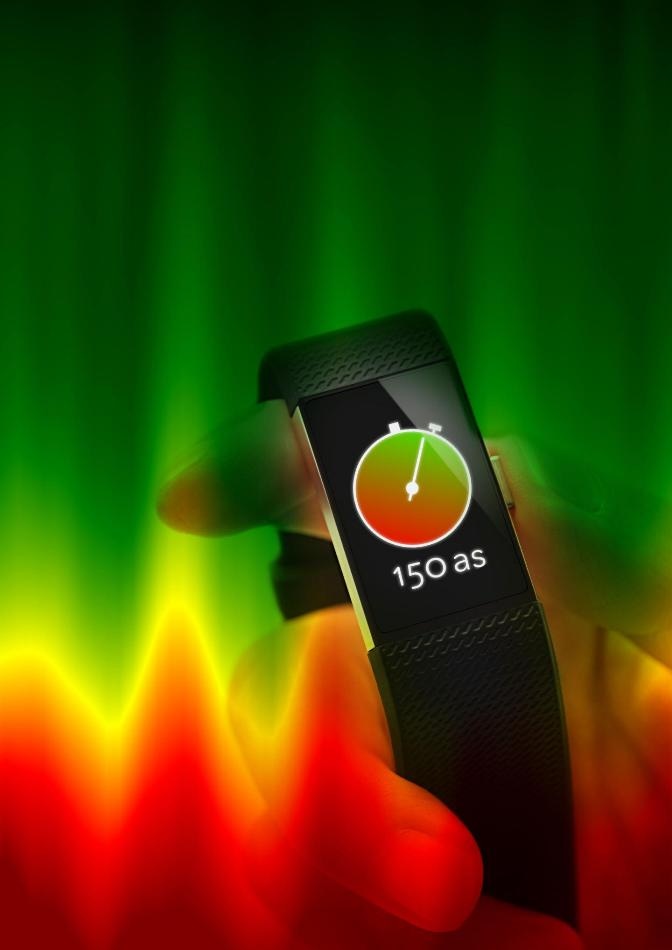May 23 2017
 A team of physicists clocked the time it takes electrons to leave a dielectric after their generation with extreme ultraviolet light. The measurement (false color plot) was the first of its kind in a dielectric material and yielded a time of 150 attoseconds (as), from which the physicists determined that inelastic scattering in the dielectric takes about 370 as. (Dennis Luck, Thorsten Naeser/LMU)
A team of physicists clocked the time it takes electrons to leave a dielectric after their generation with extreme ultraviolet light. The measurement (false color plot) was the first of its kind in a dielectric material and yielded a time of 150 attoseconds (as), from which the physicists determined that inelastic scattering in the dielectric takes about 370 as. (Dennis Luck, Thorsten Naeser/LMU)
The scattering behavior of electrons in a non-conducting material has been monitored in real-time by an international team of physicists. Their insights could be of efficient use in radiotherapy.
Electrons in non-conducting materials can be referred to as ‘sluggish’. They generally remain fixed in a location, deep inside an atomic composite. It is thus comparatively still in a dielectric crystal lattice. This idyll has recently been shaken up by a team of physicists headed by Matthias Kling, the leader of the Ultrafast Nanophotonics group in the Department of Physics at LMU, and a number of research institutions, including the Max Planck Institute of Quantum Optics (MPQ), the Institute of Photonics and Nanotechnologies (IFN-CNR) in Milan, the Institute of Physics at the University of Rostock, the Max Born Institute (MBI), the Center for Free-Electron Laser Science (CFEL) and the University of Hamburg. These researchers, for the very first time, have succeeded in directly observing the interaction of electrons and light in a dielectric, a non-conducting material, on timescales of attoseconds (billionths of a billionth of a second). The recent issue of the journal Nature Physics published this study.
Light flashes lasting only a few hundred attoseconds were beamed by the scientists onto 50 nanometer thick glass particles, which discharged electrons inside the material. Simultaneously, the glass particles were irradiated by an intense light field, which interacted with the electrons for just a few femtoseconds (millionths of a billionth of a second), making them to oscillate. Generally, this resulted in two different reactions by the electrons. They initially started to move and then collided with atoms present inside the particle, either inelastically or elastically. The electrons were able to freely move between each of the interactions for just a few ångstrom (10-10 meter) because of the dense crystal lattice. “
Analogous to billiard, the energy of electrons is conserved in an elastic collision, while their direction can change. For inelastic collisions, atoms are excited and part of the kinetic energy is lost. In our experiments, this energy loss leads to a depletion of the electron signal that we can measure.
Professor Francesca Calegari, CFEL, University of Hamburg
Since chance decides whether a collision takes place inelastically or elastically, with time inelastic collisions will ultimately occur, bringing down the number of electrons that scattered only elastically. By employing accurate measurements of the electrons’ oscillations within the intense light field, the researchers were able to discover that it takes almost 150 attoseconds on average until elastically colliding electrons go away from the nanoparticle.
Based on our newly developed theoretical model we could extract an inelastic collision time of 370 attoseconds from the measured time delay. This enabled us to clock this process for the first time.
Professor Thomas Fennel, University of Rostock
The findings of these researchers could benefit medical applications. With these global first ultrafast measurements of electron motions inside non-conducting materials, the researchers have succeeded in obtaining significant insight into the interaction of radiation with matter, which shares similarities with human tissue. The energy of the electrons that were released is controlled with the incident light, so that the process can be analyzed for a wide range of energies and for different dielectrics.
Every interaction of high-energy radiation with tissue results in the generation of electrons. These in turn transfer their energy via inelastic collisions onto atoms and molecules of the tissue, which can destroy it. Detailed insight about electron scattering is therefore relevant for the treatment of tumors. It can be used in computer simulations to optimize the destruction of tumors in radiotherapy while sparing healthy tissue.
Professor Matthias Kling, Department of Physics, LMU
Next, the researchers plan to replace the glass nanoparticles with water droplets in order to study the interaction of electrons with the exact substance which makes up the major part of living tissue. (Nature Physics 2017)